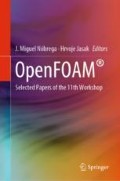Abstract
Manipulating CAD geometry using primitive components rather than the originating software is typically a challenging prospect. The parameterisation used to define the geometry of a model is often integral to the efficiency of the design. Even more crucial are the relations (constraints) between those parameters that do not allow the model to be under-defined. However, access to these parameters is lost when making the CAD model portable. Importing a standard CAD file gives access to the Boundary Representation (BRep) of the model and consequently its boundary surfaces which are usually trimmed patches. Therefore, in order to connect Adjoint optimization and Computational Fluid Dynamics to the industrial design framework (CAD) in a generic manner, the BRep must be used as a starting point to produce volume meshes and as a means of changing a model’s shape. In this study, emphasis is given firstly, to meshing (triangulation) of a BRep model as a precursor to volume meshing and secondly, to the use of techniques similar to Free Form Deformation for changing the model’s shape.
Access this chapter
Tax calculation will be finalised at checkout
Purchases are for personal use only
References
Han, J., Requicha, A.: Feature recognition from CAD models. IEEE Comput. Graph., 18(2), 80–94 (1998)
Shah, J. J., Anderson, D., Kim, Y. S., Joshi, S.: A Discourse on Geometric Feature Recognition From CAD Models. J. Comput. Inf. Sci. Eng., 1(1), 41 (2001)
Subrahmanyam, S., Wozny, M.: An overview of automatic feature recognition techniques for computer-aided process planning. Comput. Ind., 26(1), 1–21 (1995)
Nowacki, H., Dannenberg, L.: Approximation Methods Used in the Exchange of Geometric Information via the VDA/VDMA Surface Interface. Product Data Interfaces in CAD/CAM Applications, 150–159 (1986)
Mantyla, M. (1988). An introduction to solid modeling. Rockville, MD: Computer Science Press.
Stroud, I. (2006). Boundary representation modelling techniques. London: Springer.
TUM Department of Mechanical Engineering, Chair of Aerodynamics and Fluid mechanics. Retrieved from: www.aer.mw.tum.de/en/research-groups/automotive/drivaer
Piegl, L., Tiller, W. (1997). The NURBS book. Berlin: Springer.
Papadimitriou, D., Giannakoglou, K.: A continuous adjoint method with objective function derivatives based on boundary integrals, for inviscid and viscous flows. Comput. Fluids, 36(2), 325–341 (2007)
Papoutsis-Kiachagias, E., Zymaris, A., Kavvadias, I., Papadimitriou, D., Giannakoglou, K.: The continuous adjoint approach to the k turbulence model for shape optimization and optimal active control of turbulent flows. Eng. Optimiz., 47(3), 370–389 (2014)
Schberl, J.: NETGEN An advancing front 2D/3D-mesh generator based on abstract rules. Computing and Visualization in Science, 1(1) 41–52 (1997)
Meagher, D.: Geometric modeling using octree encoding. Comput. Vision Graph, 19(2), 129–147 (1982)
Isaac, T., Burstedde, C., Ghattas, O. (2012) : Low-Cost Parallel Algorithms for 2:1 Octree Balance. 2012 IEEE 26th International Parallel and Distributed Processing Symposium
Frey, P. J., George, P. L. (2008). Mesh generation: Application to finite elements. London: ISTE.
Mavriplis, D. J.: An Advancing Front Delaunay Triangulation Algorithm Designed for Robustness. J. Comput. Phys., 117(1), 90–101 (1995)
Tristano, J. R., Owen, S. J., Canann, S. A.: Advancing Front Surface Mesh Generation in Parametric Space Using a Riemannian Surface Definition (1998), https://doi.org/10.1.1.36.630
Herrmann, L. R.: Laplacian-isoparametric grid generation scheme. J. Eng. Mech. Div-ASCE, 102(5), 749–756 (1976)
Cheng, S., Jin, J.: Edge Flips in Surface Meshes. Discrete Comput. Geom., 54(1), 110–151 (2015)
Piegl, L., Tiller, W.: Parametrization for surface fitting in reverse engineering. Comput. Aided Design, 33(8), 593–603 (2001)
Varady, T., Martin, R. R., Cox, J.: Reverse engineering of geometric modelsan introduction. Comput. Aided Design, 29(4), 255–268 (1997)
Sederberg, T. W., Parry, S. R.: Free-form deformation of solid geometric models. Comp. Graph., 20(4), 151–160 (1986)
Jameson, A.: Aerodynamic design via control theory. J. Sci. Comput. 3(3), 233–260 September (1988).
Pironneau, O.: On optimum design in fluid mechanics. Journal of Fluid Mechanics 64(1), 97–110 (1974).
Thvenin, D. and Janiga, G.: Optimization and Computational Fluid Dynamics. Springer Publishing Company, Incorporated, 1st edition, (2008)
Giles, M. B., Duta, M. C., Mller, J.-D., and Pierce, N. A.: Algorithm developments for discrete adjoint methods, (2001).
Vishnampet, R., Bodony, D. J., and Freund, J. B.: A practical discrete-adjoint method for high-fidelity compressible turbulence simulations. J. Comput. Phys. 285(C), 173–192 March (2015).
Giannakoglou, K. C. and Papadimitriou, D. I.: Adjoint Methods for Shape Optimization, 79–108. Springer Berlin Heidelberg, Berlin, Heidelberg (2008).
Giannakoglou, K. C., Papadimitriou, D. I., Papoutsis-Kiachagias, E. M., and Kavvadias, I. S.: Aerodynamic Shape Optimization Using Turbulent Adjoint And Robust Design in Fluid Mechanics, 289–309. Springer International Publishing, Cham (2015).
Othmer, C.: Implementation of a continuous adjoint for topology optimization of ducted flows, 2007 (2007).
Othmer, C.: A continuous adjoint formulation for the computation of topological and surface sensitivities of ducted flows. International Journal for Numerical Methods in Fluids 58(8), 861–877 (2008).
Papoutsis-Kiachagias, E., Kyriacou, S., and Giannakoglou, K.: The continuous adjoint method for the design of hydraulic turbomachines. Computer Methods in Applied Mechanics and Engineering 278(Complete), 621–639 (2014).
Martin, M. J., Andres, E., Lozano, C., Valero, E.: Volumetric b-splines shape parametrization for aerodynamic shape design. Aerosp. Sci. Techno., 37, 26–36 (2014)
Yan, X., Su, X. G.: Linear Regression Analysis (2009), https://doi.org/10.1142/6986
Acknowledgements
The work shown here is part of the IODA (Industrial Optimal Design using Adjoint CFD) Project. Research topic: Intuitive interfaces for optimisation parameterisation, constraint definition and automated mesh-to-CAD conversion.
The project leading to this application, has received funding from the European Unions Horizon 2020 research and innovation programme under the Marie Sklodowska-Curie grant agreement No. 642959.
Author information
Authors and Affiliations
Corresponding author
Editor information
Editors and Affiliations
Rights and permissions
Copyright information
© 2019 Springer Nature Switzerland AG
About this chapter
Cite this chapter
Damigos, M., De Villiers, E. (2019). CAD-Based Parameterization for Adjoint Optimization. In: Nóbrega, J., Jasak, H. (eds) OpenFOAM® . Springer, Cham. https://doi.org/10.1007/978-3-319-60846-4_2
Download citation
DOI: https://doi.org/10.1007/978-3-319-60846-4_2
Published:
Publisher Name: Springer, Cham
Print ISBN: 978-3-319-60845-7
Online ISBN: 978-3-319-60846-4
eBook Packages: EngineeringEngineering (R0)

